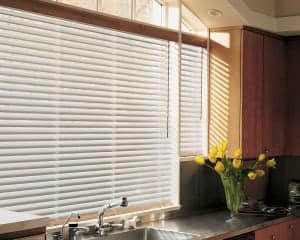While it’s going to be really difficult for you to get a tan through a window, it is easy for plants to do photosynthesis through the window. Glass typically blocks UV light, which prevents you from getting a nice tan. But glass doesn’t block visible light, which is the range that green plants use to perform photosynthesis. That means that you don’t need to open the window panes for your plants to be happy and strong.
Still, windows are rarely just a pane of glass. There are often multiple panes, different kinds of screens, and some kind of treatment or blinds. Some window treatment strategies are going to be better for plants and others will not be quite so friendly. In this post, we’re going to look at some window treatments that are great for strong plant growth.
How do Plants Grow?
Plants take in sunlight and grow through photosynthesis. Plants have chloroplasts, which respond to light levels and perform the photosynthesis. This means that they can grow mostly using the sun as an energy source, although they will also pull nutrients from soil and water. Many plants will be able to pull certain nutrients out of the air as well.
Strategies for Growing Plants Next to Windows
Light Intensities
This can vary by your geographical location, but it works for Europe, much of Asia, and much of North America. Light is least intense year-round in north facing windows. They usually have the most shade. Shade loving plants may thrive in north facing windows because they get the most sunlight during the summer months.
South-facing windows have a strong amount of light. The sun usually moves from east to west, which means that in most seasons, in many locations, the sun will track along a southern window.
Eastern-facing windows will get a lot of light in the morning and are great for plants that need moderate sunlight or only the morning sun. West facing windows are great for the plants that love the light the most, because they get the full intensity of the sun by the afternoon.
Keep Them Close
Plants don’t use UV light in order to perform photosynthesis, so glass is not going to disrupt too much of the growing process. Plants use the visible light spectrum for photosynthesis, which is still going to come through the window pane. However, keep in mind that your gut is going to be right when it comes to plants and window panes. The more light that you see coming through the window, the more light and sunshine your plant is getting. This means that plants far away from windows, even if the sun is gracing them through the glass, are likely getting more refracted forms of light and are not getting as much sunshine. Plants that are really close to windows will get more light than far away plants.
What About Artificial Light?
Plants love sunshine, but more than that, plants just love light. There are plenty of kinds of lighting that you can get that are designed for plants to thrive. Not every bulb will be perfect for every plant, so make sure to do your research on particular bulbs and the kind of plants that they will support.
Windowsill-Friendly Plants
Cactus, succulents, umbrella plants, geraniums, and umbrella plants are all really great for growing on windowsills. Any plant that says it needs direct sunlight can be grown through a window as long as the plant is placed close to the window, and the window treatment makes sure that plenty of visible light gets through the window.
What Treatments are Good for Plants?
Single-Pane Glass
If you’ve been in the market for new windows recently, you’ve probably heard the sung praises for glass that comes with multiple panes. But the thicker your glass, the more light you’re going to reflect, trap, and block. This won’t be as friendly to your plants! If you live in an area where the cold is an issue, then you won’t want to sacrifice the insulation of your home just to grow a few plants–but if you have a mild weather climate, consider installing windows that are built for plant growth.
Shades
Shades are probably a plant’s best friend. They are easy to roll up and down, so it’s really simple to expose your plants to the maximum amount of sunlight by getting the treatment out of the way. Also keep in mind that there are a couple of additional things that shades can give you. There are solar shades, which have transparency amounts that can allow visible light to get through the shade and help your plant grow. Transparencies come in a variety of percentages. 1% transparency is low, and 100% would be no shades at all!

Another thing to consider is automatic shades. Shades that are hooked up to smart home technology can raise and lower during certain times of the day, so you can automatically control how much sunlight a given plant gets by setting the shades on a timer. This is great for plants that are really fickle and need precise amounts of sunlight.
Fabrics that are Sheer
Visible light helps your plants grow. This means that you can even put up curtains, as long as the curtains are sheer. Sheer fabrics allow visible light into the room and can help your plants grow. Drapes, curtains, and even roman shades can all be built from sheer fabrics. The color won’t matter as much as the amount of light that gets through.
Blinds
If you’re optimizing a room for plant growth, then you’ll want to skip the blinds. Blinds have to be pulled all the way up in order to maximize sunshine, and that can be done a bit easier with a shade. If you try to keep blinds lowered and open, the plants will get hit with streaks of shade that limit the amount of light they can intake. Still, if you don’t need the most amount of light possible, blinds will still do the trick.






